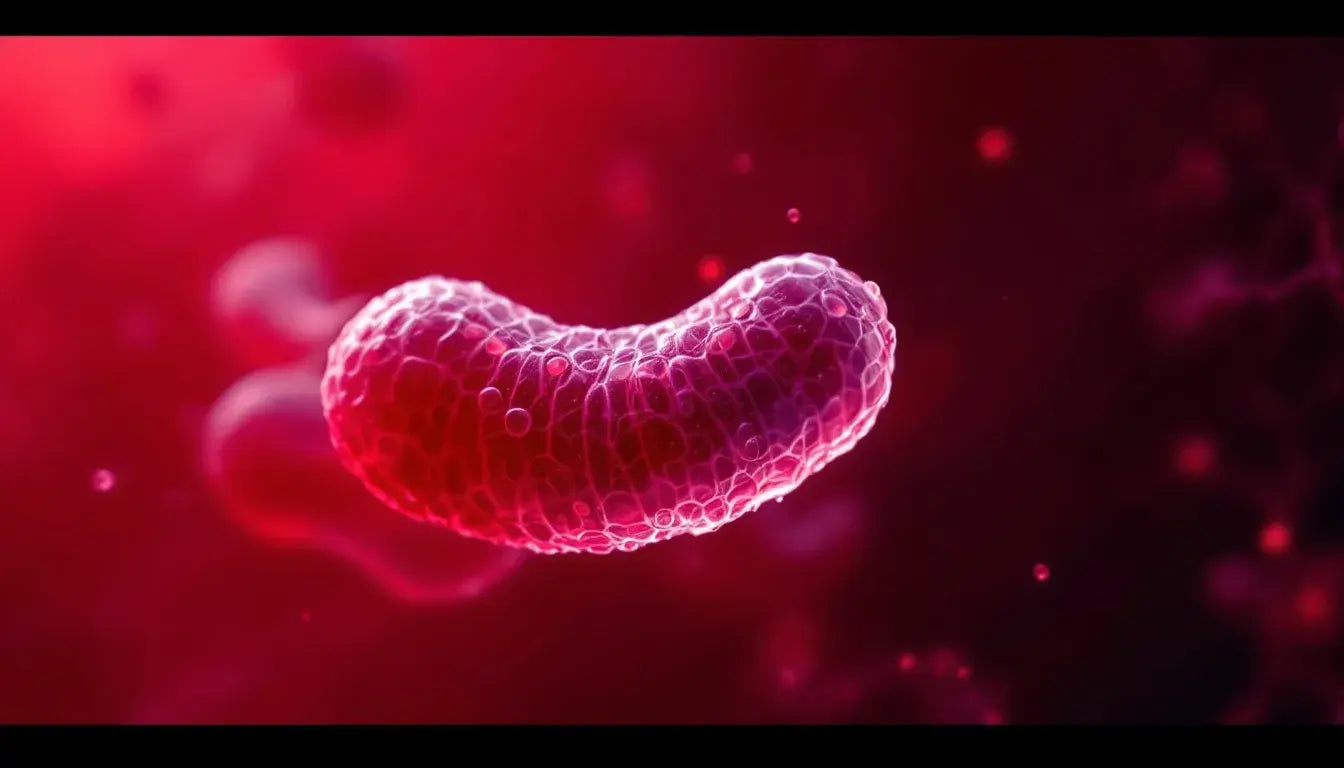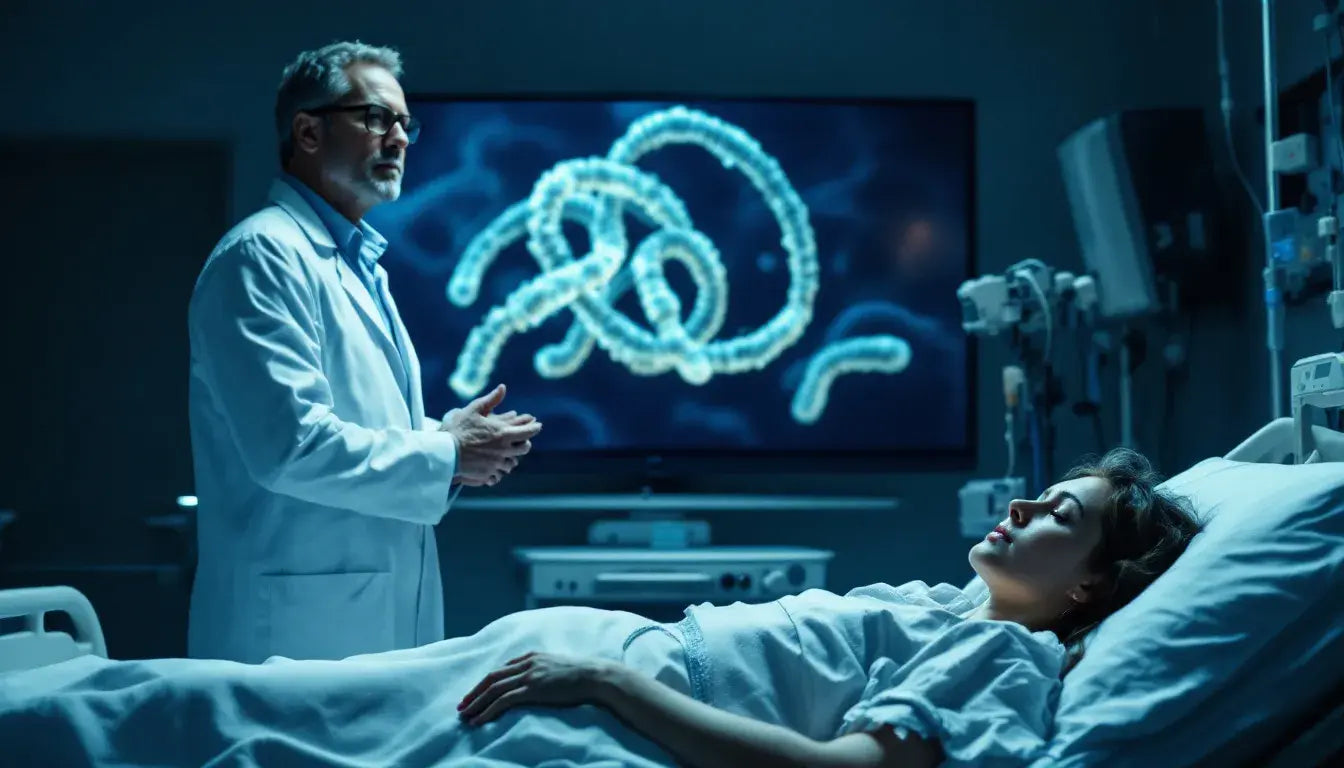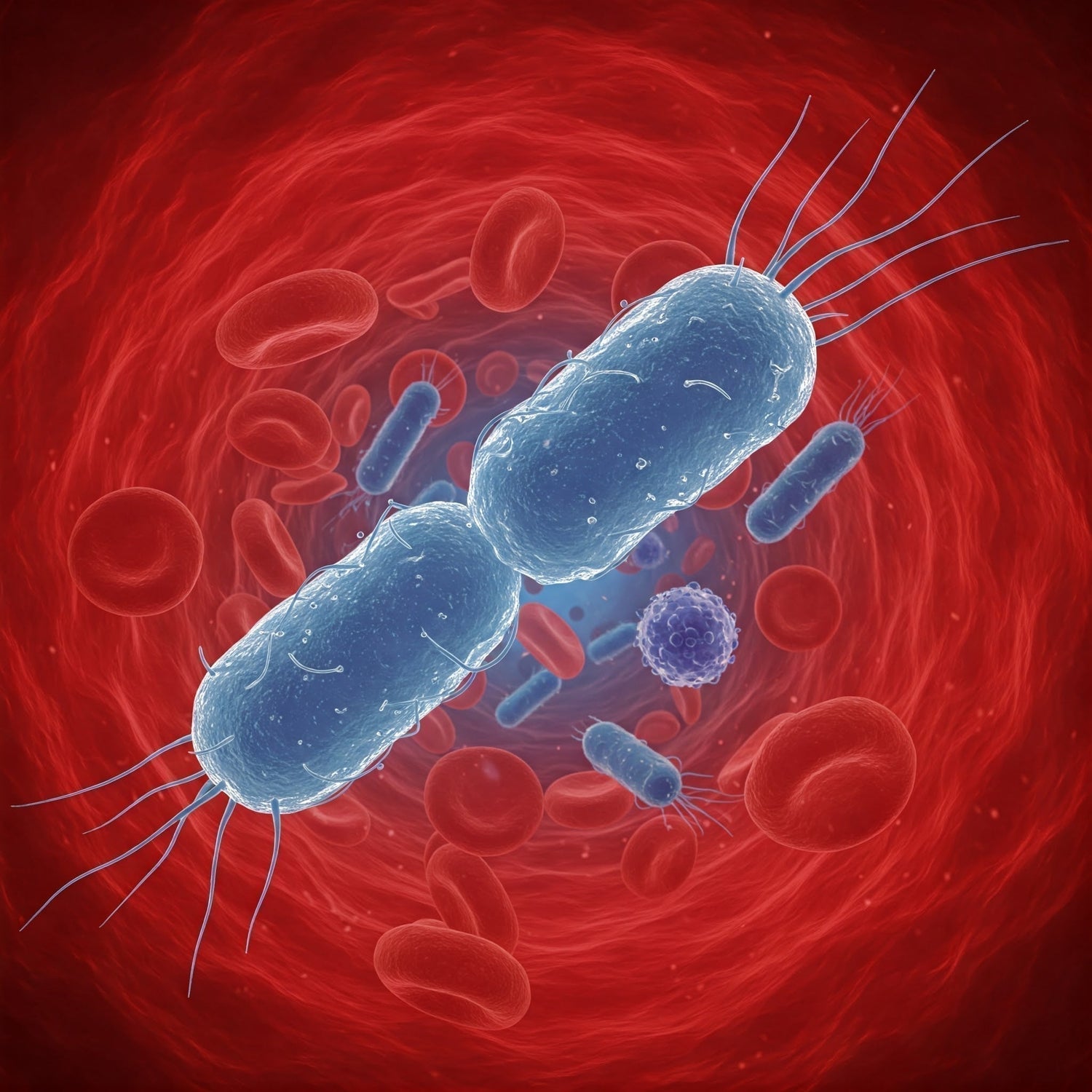E. coli in the bloodstream is a serious condition that needs immediate medical attention due to its potential to cause life-threatening complications, such as sepsis. One of the primary methods of contracting E. coli infections is through eating contaminated food. This article will discuss the symptoms, causes, treatment options, and prevention of E. coli in the bloodstream.
Key Takeaways
-
E. coli bloodstream infections can lead to severe complications, including sepsis and hemolytic uremic syndrome, requiring immediate medical attention.
-
Common symptoms of E. coli bloodstream infections include fever, chills, and gastrointestinal issues, often appearing 3 to 4 days post-exposure.
-
Preventive measures such as proper handwashing, safe food handling, and using cleaning technologies like the Milerd Detoxer are essential to reduce the risk of E. coli infections.
Understanding Escherichia coli Bloodstream Infections

The bacterium Escherichia coli (E. coli) is a common inhabitant of the human and animal intestinal tracts. It contributes to gut health, but some strains can turn harmful and lead to significant health complications if they spread beyond the intestines. A particularly severe consequence is escherichia coli bacteremia, which occurs when E. coli bacteria infiltrate the bloodstream, resulting in widespread infection.
Bloodstream infections caused by E. coli are critical conditions that necessitate prompt medical intervention due to their capacity for rapid advancement into sepsis—an extreme and potentially fatal inflammatory reaction in the body. The pathogenicity of E. coli stems from its virulence factors such as adhesion molecules and toxins that enable it to initiate and perpetuate infections once inside the bloodstream. These elements significantly increase its risk level upon breaching our internal defenses.
There is growing alarm within healthcare circles regarding increasing incidents of E.coli bloodstream infections with escalating dangers associated with them, highlighting an urgent need for better understanding both cause-specific mechanisms behind this condition as well as proactive prevention strategies aimed at professionals within medicine alongside everyday people—particularly concerning systemic blood infections caused by e.coli bacteria.
A myriad of avenues exist through which one might contract an infection from this source—from consuming food tainted with these microbes to acquiring hospital-related (nosocomial) infections—underscoring why maintaining diligent hygiene practices coupled with strict adherence to principles governing food safety cannot be understated in importance. E. coli outbreaks can occur from contaminated water sources, including municipal supplies and private wells.
To arm you against potential risks posed by E.coli invaders operating under cover throughout your system’s highways, we will delve next into symptomatic manifestations associated explicitly with incursions by these organisms targeting your vascular pathways so you may quickly identify danger signals should they arise warranting immediate action on your part.
What is E. coli?
Escherichia coli, commonly known as E. coli, is a type of bacteria that naturally resides in the intestines of humans and animals. While most strains of E. coli are harmless and even beneficial for gut health, certain strains can cause severe illnesses and infections. These harmful strains can lead to conditions such as bloody diarrhea, urinary tract infections, and more serious complications if they enter the bloodstream.
E. coli is a gram-negative bacterium that is prevalent in the environment. It can be spread through contaminated food, water, and surfaces. Consuming contaminated food, such as undercooked meat or raw milk, and drinking water tainted with E. coli are common ways people become infected. Understanding the nature of E. coli and its transmission routes is crucial for preventing infections and maintaining good health.
Symptoms of E. coli Bloodstream Infections

Identifying E. coli bloodstream infections promptly is crucial for avoiding serious health issues and ensuring a rapid recovery. Typical signs such as fever, chills, and digestive problems usually emerge within three to four days after exposure to the bacteria, although they can appear sooner or significantly later—ranging from just one day up to more than a week post-exposure.
Initially, these symptoms might be nonspecific and mimic those of other illnesses. As the infection intensifies, more pronounced symptoms may arise based on where in the body it has taken hold. Infections in the urinary tract often result in discomfort during urination, whereas gastrointestinal afflictions are likely to cause intense stomach pain and blood-stained diarrhea.
Nosocomial bloodstream infections caused by E. coli pose an additional risk within hospital environments due to existing medical conditions among patients there as well as possible resistance to antibiotics—an occurrence that necessitates vigilant surveillance and quick medical intervention when an infection is suspected.
The seriousness of these manifestations underscores the importance of recognizing them swiftly so that appropriate treatment measures can commence immediately. Moving forward, we will delve into how E. coli bloodstream infections originate along with which factors increase susceptibility towards contracting them.
Causes and Risk Factors
To avert bloodstream infections caused by E. coli, it’s essential to comprehend the sources and risk elements involved. Typically, E. coli can invade the bloodstream via fecal-oral spread, commonly through ingesting contaminated food or water. Key risks include eating raw or insufficiently cooked meats and drinking unpasteurized beverages.
Strains like Shiga toxin-producing E. coli (STEC) are notably inclined to induce serious illness and complications. These particular strains are frequently implicated in outbreaks related to tainted food items, especially meats that haven’t been thoroughly cooked. Contaminated bodies of water too might act as reservoirs for these hazardous E.coli variants if polluted with animal or human feces.
Those with weakened immune defenses, such as older individuals, people managing chronic conditions, or patients receiving treatments that suppress immunity, face an elevated likelihood of contracting severe forms of infection from this bacterium. Increased exposure may result from activities such as bathing in contaminated waters or interacting with animals at petting zoos.
A considerable number of cases where E.coli infects the bloodstream stem from urinary tract infections (UTIs), particularly among elderly persons aged between 60 and 75 years old. Meanwhile, abdominal diseases also stand out as another acknowledged hazard for grave manifestations of bloodborne coliform contagion Given these identified dangers it becomes evident why some demographics demonstrate heightened susceptibility making prevention strategies all the more vital.
Clinical Characteristics of E. coli Bloodstream Infections
E. coli bloodstream infections occur when the bacteria enter the bloodstream, leading to a systemic infection. The clinical characteristics of these infections can vary widely depending on the severity and the individual’s overall health. Common symptoms include fever, chills, nausea, vomiting, and abdominal pain. These symptoms often appear within a few days of exposure to the bacteria.
In severe cases, E. coli bloodstream infections can escalate to sepsis, a life-threatening condition that requires immediate medical attention. Sepsis is characterized by a widespread inflammatory response that can lead to organ failure and death if not promptly treated. Recognizing the clinical characteristics of E. coli bloodstream infections is essential for early diagnosis and effective treatment, which can significantly improve patient outcomes.
Diagnosis Methods
It is essential to accurately diagnose E. coli bloodstream infections for successful treatment. The presence of E. coli in the blood can be confirmed through blood culture tests, which are instrumental in determining suitable treatment plans.
The effectiveness of blood cultures in identifying E. coli may differ based on when and how samples are taken. To ascertain the existence and severity of an E. coli bloodstream infection, both blood and stool specimens are typically utilized for diagnosis purposes. Occasionally, advanced molecular methods like nucleic acid amplification tests might swiftly pinpoint specific strains of E. coli from stool samples, thereby enabling prompt diagnosis and initiation of therapy.
Comprehending the clinical features as well as outcomes linked with these infections is crucial for informed therapeutic choices. Accurate diagnostic techniques contribute significantly to controlling the spread within medical facilities.
Moving forward, we will delve into available treatments for combating E. coli bloodstream infections while stressing urgent intervention’s significance utilizing proper medical tactics.
Treatment Options for E. coli Bloodstream Infections

It is critical to promptly address E. coli bloodstream infections to avert serious outcomes like sepsis. Typically, treatments may include antibiotics such as ciprofloxacin and trimethoprim/sulfamethoxazole. Increasing resistance to multiple drugs complicates the management of these infections.
Ensuring patients receive proper support care that includes adequate hydration and vigilant supervision is key in mitigating symptoms and warding off complications from E. coli bloodstream infections. Cases with heightened severity might necessitate admission into a hospital for more intensive treatment and constant observation.
Fluctuations exist in the death rates associated with E. coli bloodstream infections, which can be exacerbated by conditions like sepsis leading to rapid health decline. It underscores why early action coupled with suitable antibiotic therapy is crucial. Subsequently, we will delve into potential challenges arising from these complications as well as stress on the significance of both prompt and effective intervention strategies.
Complications of E. coli Bloodstream Infections

Untreated E. coli bloodstream infections can precipitate dire health consequences, including sepsis which initiates a robust inflammatory reaction that dramatically escalates the fatality risk. Without intervention, septicemia caused by E. coli has the potential to result in organ failure and death.
A severe aftermath of infection with Shiga toxin-producing Escherichia coli is hemolytic uremic syndrome (HUS), afflicting roughly 5% to 10% of those infected. HUS constitutes an acute threat capable of inducing kidney failure among other significant medical problems. Thus, avoiding antibiotics for managing these particular infections is advised due to heightened complication risks.
For critical instances where individuals are grappling with escherichia coli bloodstream infections, hospital admission becomes crucial for administering specialized treatment and ensuring persistent supervision. Recognizing the possibility for enduring health effects alongside requisite sophisticated care underscores both preventing such infections diligently and securing timely medicinal attention once they surface.
To prevent contracting E. coli infections, carefully consider hygiene protocols along with food handling safety measures.
Prevention Strategies

Preventing E. coli infections is best achieved through proper handwashing and following the four steps of food safety: clean, separate, cook, and chill. Consuming pasteurized milk and juice helps eliminate harmful bacteria.
Traditional washing methods can leave harmful bacteria like E. coli on food surfaces. The Milerd Detoxer provides a comprehensive cleaning solution using ozone technology and ultrasonic cleaning to effectively eliminate bacteria and viruses, ensuring a safer food supply.
Avoid drinking unsafe water, especially when camping or traveling. Swimming in contaminated water can lead to E. coli infections, so avoid swallowing water during such activities. These preventive measures significantly reduce the risk of infection and protect your health.
Infectious Diseases and E. coli Infections
E. coli infections can lead to a variety of infectious diseases, each with its own set of symptoms and severity. The most common type of E. coli infection is a urinary tract infection (UTI), which can cause symptoms such as a burning sensation during urination, frequent urination, and abdominal pain. UTIs are particularly prevalent among women and older adults.
Pneumonia is another serious type of E. coli infection, characterized by symptoms like coughing, difficulty breathing, and chest pain. This condition requires prompt medical intervention to prevent complications. Sepsis, the most severe form of E. coli infection, occurs when the body’s response to the infection becomes uncontrolled, leading to widespread inflammation and potentially fatal outcomes. Understanding the range of diseases caused by E. coli infections underscores the importance of early detection and treatment.
Contaminated Water and E. coli Infections
Contaminated water is a significant source of E. coli infections. The bacteria can enter the water supply through human and animal waste, leading to infections in people who drink or come into contact with the contaminated water. Ground and surface water can become contaminated with E. coli bacteria through various sources, including agricultural runoff, sewage overflows, and animal waste.
Drinking contaminated water can result in severe gastrointestinal illnesses and, in some cases, lead to hemolytic uremic syndrome (HUS), a rare but serious complication. HUS can cause kidney failure and other severe health issues, particularly in young children and the elderly. To reduce the risk of E. coli infections from contaminated water, it is essential to ensure safe drinking water practices and avoid swimming in potentially polluted waters.
How Detoxer Can Help Reduce Health Risks

Utilizing ultrasonic waves coupled with active oxygen, the Milerd Detoxer proficiently eliminates as much as 99% of pernicious food contaminants, including E. coli. The device purifies edibles by neutralizing various pollutants like bacteria, viruses, pesticides, heavy metals, mold spores and eggs from parasites—rendering your meals devoid of harmful microorganisms.
The efficiency of the Milerd Detoxer is bolstered by its use of ultrasonic technology that generates tiny bubbles adept at removing grime and microbial presence on edible items’ exteriors. This surpasses conventional cleaning techniques in effectiveness. As a result, it’s particularly advantageous for households with children to maintain safe eating practices.
Designed for optimal ease-of-use whether at home or while travelling due to its rechargeable battery feature—the portable detoxification unit can complete its sanitization cycle within just 10 minutes to assure decontamination of foods quickly and conveniently. Accompanying the product are an adapter, USB Type-C cable along with a user manual ensuring effortless operation right out of the box.
Incorporating this gadget into your daily routine could significantly cut down risks stemming from E. coli infections among other health concerns linked to foodborne pathogens—making it an instrumental addition for safeguarding your family’s welfare against disease transmission through contaminated nourishment.
Summary
In essence, bloodstream infections caused by E. coli are a critical medical issue that requires prompt and appropriate clinical intervention. It’s vital to identify symptoms promptly, grasp the underlying causes and risk factors related to these infections, as well as be aware of diagnostic techniques in order to effectively control their impact. Swift and apt treatment can markedly mitigate potential complications and enhance patient recovery prospects.
To minimize the likelihood of contracting an E. coli infection, it is imperative to adhere to stringent hygiene standards alongside food safety protocols. The Milerd Detoxer presents a sophisticated means for assuring food security, offering reassurance while diminishing health hazards tied with E. coli contamination. By staying vigilant and adopting preventive strategies proactively, individuals can safeguard themselves and those they care about from the threat posed by E. coli contaminations within the bloodstream.



Leave a comment
This site is protected by hCaptcha and the hCaptcha Privacy Policy and Terms of Service apply.